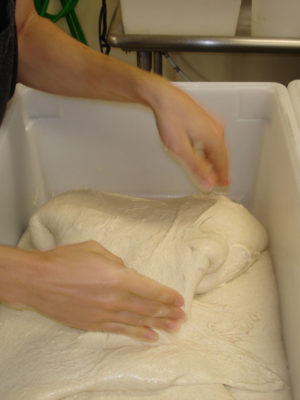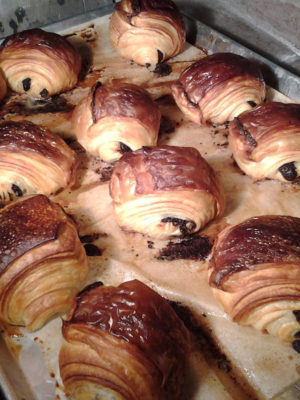Crafting Artisan Bread
Muddy Fork Bakery’s artisans mill local, organic grain into flour, ferment it with a natural sourdough starter and bake the bread in our wood-fired, brick oven. Our process coaxes maximum flavor and nutrition from the wholesome grain.
We have a weekly rhythm to our work:
- Wednesday is a day for firing the oven and milling whole-grain flours.
- Thursday is for making doughs for the breads and pastries, firing the oven, and doing other prep work. We end the day by shaping most of our loaves and putting them to rest in the cooler.
- Fridays we work with croissants throughout the day. By afternoon we begin the bake, turning out breads for many hours, and as the heat dips, pastries follow. Fresh breads and warm pastries are loaded up for farmers’ market and deliveries early Saturday.
- On Sundays we make Neighbor Loaves, sponsored by our customers and delivered to Mother Hubbard’s Cupboard.
- Tuesdays we are back in the bakery for granola making, capturing some of the leftover heat stored in the masonry of the oven, before heating the oven again on Wednesdays.
Our Process
Every step of our process brings out the flavor, nutrition and character inherent in the living grain.
The Grain
The day before baking we mill all of our whole-grain flours on a stone mill imported from Denmark. We use only organic grains, including wheat, rye, kamut and spelt. The freshly-milled flour contains all the aroma and nutrients of the grain, which begin to dissipate as soon as the grain is milled.
Most of our grain comes from Janie’s Farm in Ashkum, IL. Our primary bread flour is a stonemilled, 80% extraction flour milled at Janie’s Mill. The rest of our grain comes from Janie’s Mill’s partners.
The Oven
We bake our bread in a wood-fired brick oven. The oven has a hearth that is five feet wide by 7 1/2 feet deep, and can hold about 72 loaves of bread at one time. The hot oven core is made of firebricks and high-temperature mortar, built to a 9-in thickness in the hearth, walls and dome. It is extremely well-insulated and can retain an immense amount of heat for days.
Firing the oven
We begin the process two days before baking by building a small fire in the oven on Wednesday. We load it with scrap wood from local woodworkers and sawmills and light the fire at the front. Over a six- to twelve-hour period, the fire burns from front to back. The fire builds heat until it reaches a complete, high-temperature combustion (smoke and soot is burned off). The first, small load of wood brings the temperature up from about 300 to 450. We fire the oven all day Thursday and allow the coals to continue heating the oven through the night. Friday morning we place a heavy, insulated door in the opening and let the heat equalize 6 to 8 hours. Just before baking, we clean the ash from oven with a brush and swab it out with a wet cotton rag. The oven is ready for the bake, with the masonry at an even 650 to 680 degrees throughout.a
Preparing the Starter
We keep a natural sourdough culture that we started with our freshly-ground Indiana wheat several years ago. The morning of mixing dough, we make enough fresh starter to leaven the 400 loaves we will be making. We also prepare poolish, a yeasted sponge, to be used in combination with sourdough for some of our breads.
Making the dough
Thursday afternoons we mix dough. For the first 3 years, we mixed everything by hand in large tubs. Due to the immense amount of labor involved, we came up with a technique for developing the strength in the dough without much intensive kneading. Instead we folded the dough many times during its fermentation, between 30 to 40 minute periods of rest. While we enjoyed the work and found the results to be outstanding, we have incorporated a mechanical mixer to save our strength and time. The results of our folding and resting technique were so great that we maintain this method, and limit our use of the mixer merely to incorporating the ingredients, and achieve most the dough development through gentle folding.
Dividing, Shaping and Proofing the dough
When each dough has fermented sufficiently, we turn it out on our wood-top table and scale it into loaf-sized lumps. We round each piece and let them rest on the table. Then we shape each loaf. Some are formed with a bit of water on the table and rolled in seeds. The loaves then proof in our walk-in cooler until Friday afternoon, when we will start baking them.
Some of the bread proofs in linen-lined baskets, others between folds of linen on a wooden board, and a few loaves proof in pans that they will also bake in.
Preparing Croissants
Throughout the day on Fridays we spend time with the croissants. We mix the dough the night ahead, and in the morning we laminate the croissants. We pound grassfed, cultured butter into squares and enclose each square in a packet of dough. We roll out the packets and fold them in thirds and repeat this process two times during the day, until each packet is comprised of 27 layers of butter sandwiched between 28 layers of dough. After a rest in the cooler, we roll out each packet and cut triangles and rectangles and roll up the croissants.
Starting to Bake
Friday afternoon we begin to bake the loaves. The oven is about 660 to 670 degrees when we load the first loaves in with wooden peels. The loaves sit directly on the oven floor, or hearth, and the rapid heat transfer into the loaves causes them to spring to nearly double their size. Before they are loaded, we score each loaf with a razor blade to give it a place to burst in a pleasing way. As we are loading the oven, we add some steam with a copper watering wand. Once the oven is full, the baking loaves produce their own steam in the sealed chamber, which billows out when the door is opened.
Load Sequence
The oven holds about 72 loaves when full. Each load is a carefully planned mix of different doughs, loaded in a specific sequence to optimize results. Whole grain loaves are loaded first, in the right and left sides of the oven. Then rustic sourdough loaves are loaded into the middle, which spring more and require a more steam-saturated oven. A space is left at the front of the oven, and a peel full or two of baguettes are slid into place just before the door is closed. They will bake quickly and will be accessible for us to remove right at the front.
Baking Pastries
After each load of bread is removed, we sweep the burned flour and seeds from the oven. Heat rises from the deeper layers of brick up to the surface, partially reheating the oven. After five to six loads of bread, the surface has cooled below 500 degrees, the evening baker goes home, and the oven rests for a few hours before the morning baker arrives to bake the pastries.
Neighbor Loaves
After the bread is baked, the oven surface recovers to about 500 degrees over a period of several hours. We prepare another starter, and one baker spends Sunday mixing, shaping, and baking 75 whole-wheat pan loaves for Mother Hubbard’s Cupboard, a Bloomington food pantry, using the leftover heat from Saturday’s bake. These are Neighbor Loaves, sponsored by our customers, which help feed the community and make our nutrient-dense breads accessible to those who couldn’t otherwise afford them. Neighbor Loaves are a project of the Artisan Grain Collaborative.
Granola
By Tuesday, the day before firing the oven, the temperature has dipped to below 350 degrees, and we bake 60 to 100 pounds of granola, muesli and granola bars. We are glad to take further advantage of the “free” heat to make another product. Read more about our granola here.

































